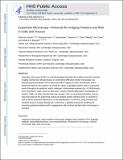Expansion Microscopy: Protocols for Imaging Proteins and RNA in Cells and Tissues
Author(s)
Asano, Shoh M.; Gao, Ruixuan; Wassie, Asmamaw T.; Tillberg, Paul W.; Chen, Fei; Boyden, Edward; ... Show more Show less
DownloadAccepted version (2.173Mb)
Terms of use
Metadata
Show full item recordAbstract
Expansion microscopy (ExM) is a recently developed technique that enables nanoscale-resolution imaging of preserved cells and tissues on conventional diffraction-limited microscopes via isotropic physical expansion of the specimens before imaging. In ExM, biomolecules and/or fluorescent labels in the specimen are linked to a dense, expandable polymer matrix synthesized evenly throughout the specimen, which undergoes 3-dimensional expansion by ∼4.5 fold linearly when immersed in water. Since our first report, versions of ExM optimized for visualization of proteins, RNA, and other biomolecules have emerged. Here we describe best-practice, step-by-step ExM protocols for performing analysis of proteins (protein retention ExM, or proExM) as well as RNAs (expansion fluorescence in situ hybridization, or ExFISH), using chemicals and hardware found in a typical biology lab. Furthermore, a detailed protocol for handling and mounting expanded samples and for imaging them with confocal and light-sheet microscopes is provided.
Date issued
2018-08Department
McGovern Institute for Brain Research at MIT; Massachusetts Institute of Technology. Media Laboratory; Massachusetts Institute of Technology. Department of Biological Engineering; Massachusetts Institute of Technology. Department of Brain and Cognitive SciencesJournal
Current Protocols in Cell Biology
Publisher
Wiley
Citation
Asano, Shoh M. et al. "Expansion Microscopy: Protocols for Imaging Proteins and RNA in Cells and Tissues." Current Protocols in Cell Biology 80, 1 (September 2018): e56 © 2018 John Wiley & Sons, Inc.
Version: Author's final manuscript
ISSN
1934-2500